
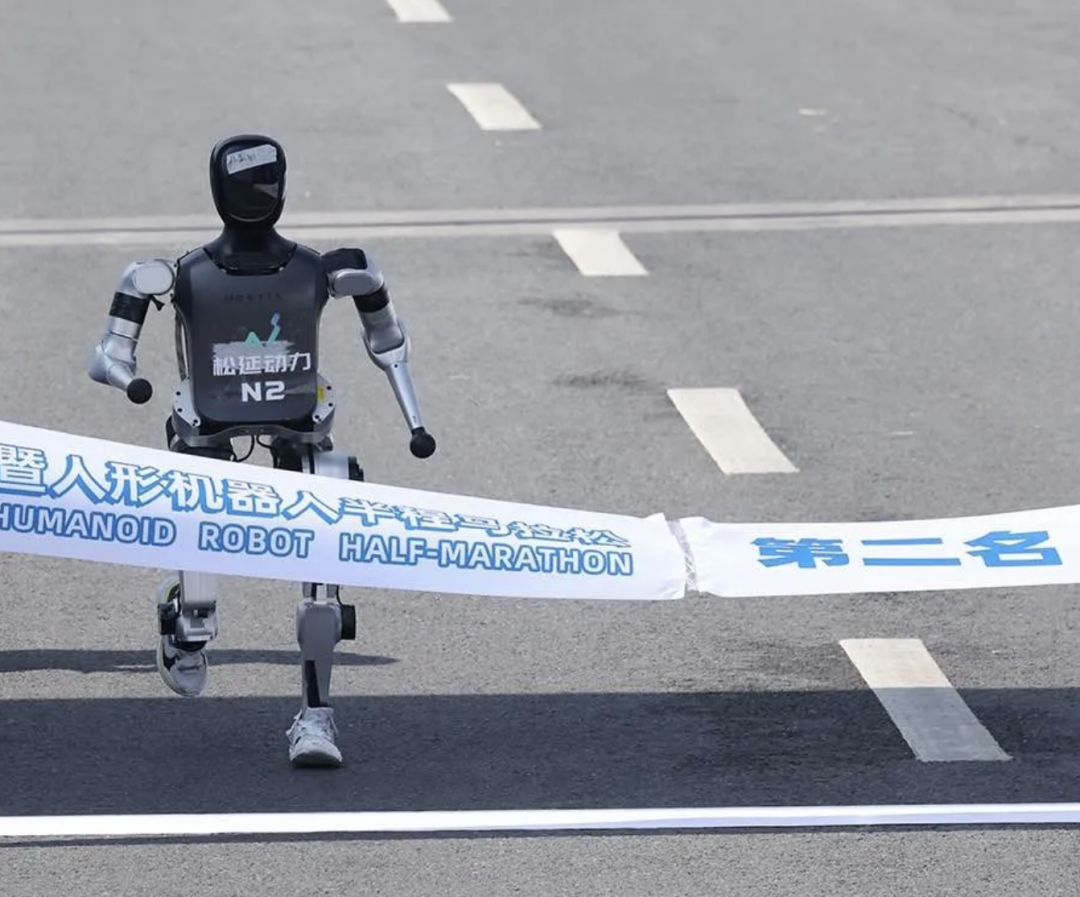
|
What does a robot need to run a marathon? |
ByYang XiaotongEditor|BaruiCover Source|OfficialAlthough delayed by strong winds for a week, the global debut of the humanoid robot half marathon remains highly anticipated.
At 7:30 AM on April 19, just before the official start of the race, many spectators had already gathered at the starting point and along the route to watch the robots. A month prior, social media users had been documenting the robots’ training processes and speculating on who would win.
According to official pre-race announcements, there were a total of 21 teams from various companies and universities participating, with team names ranging from the serious, like “Lingbao Robot Team” and “Xuanyuan Robot Team”, to the more humorous and memorable, such as “Zhanlu Charge Tornado Team” and “Bayinbuluke Forever King”, reminiscent of college students forming teams for social practice called “Whatever You Say Team”.
These robots vary in size, with the tallest being the Tiangong Ultra and the Zhurichang, both standing at 180cm, while the shortest is the “0306 Little Giant” developed by Beijing University of Science and Technology, measuring only 75cm and weighing 10kg. The heaviest is the Xuanyuan robot, standing at 172cm and weighing a hefty 88kg, with an arm load of 20kg, which is not an advantage for running a marathon.
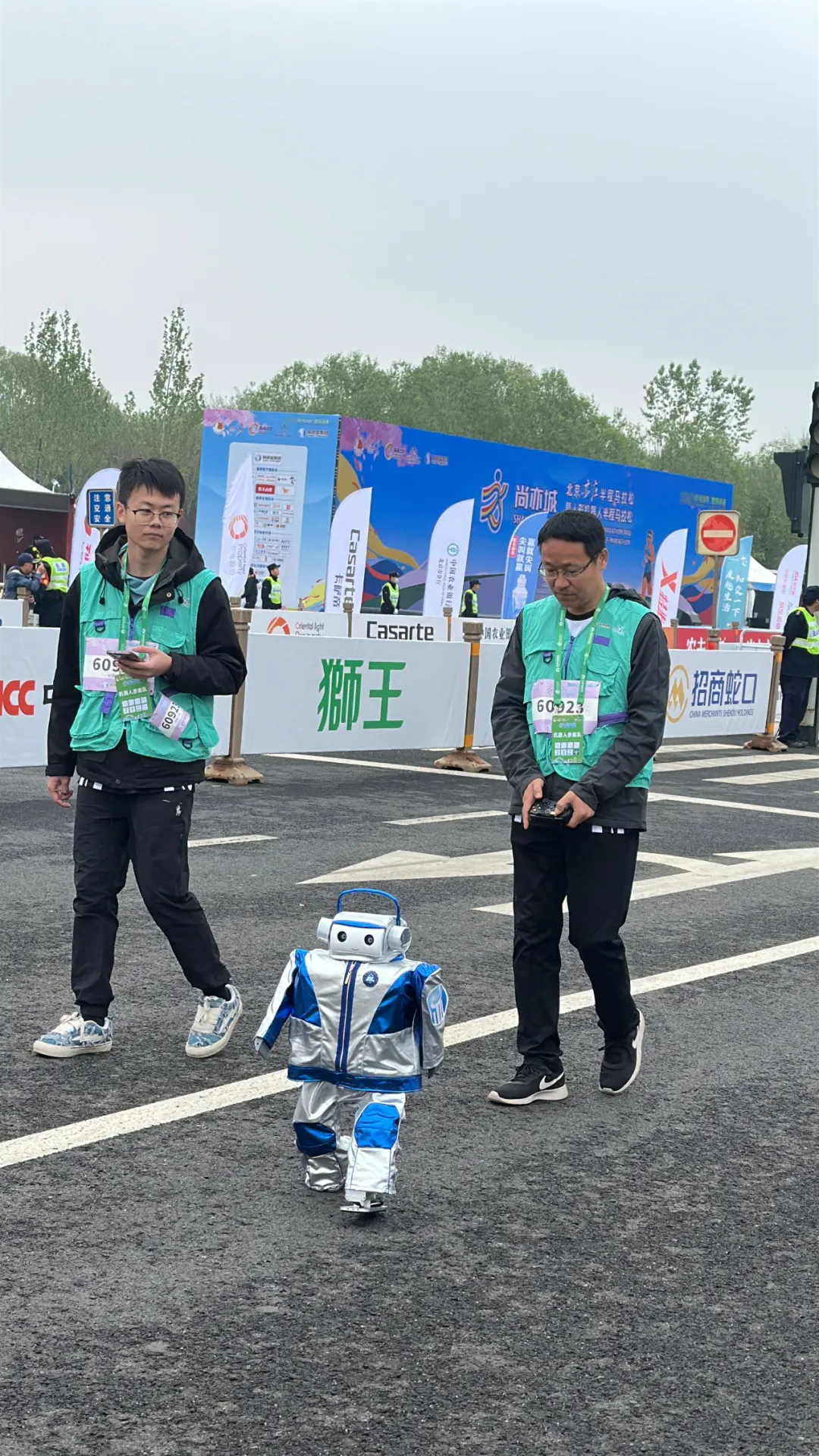
0306 Little Giant
Their advantages are varied. The Walker II is the first foot-style robot in history to walk over 100 kilometers, with a battery life of over 6 hours. The “Little Rascal” from Songyan Power has a running posture very close to that of humans, capable of efficient energy recovery and adaptive gait switching in complex terrains. The “Tiangong Team”‘s Tiangong Ultra has reached a world-leading maximum running speed of 12km/h, equipped with visual perception capabilities that allow it to easily navigate complex terrains with ditches and significant height differences.
At 6:00 AM, the unactivated robots and their operators were already waiting behind the starting point. Perhaps due to the early hour, most of the spectators at that time were elderly people strolling in the park.
At 7:00, human competitors began warming up with jumps, while the robot competitors remained eerily calm and motionless.
This Beijing Yizhuang half marathon adopted a human-robot running format, with two separate tracks along the same route.
Clearly, the robot competitors attracted more attention, not just from the media and spectators, but even from the human competitors preparing to run, who were constantly filming the robots. This raises the question of whether some of the human competitors came specifically to see the robots, as their track provided the best first-person perspective.
At 7:30 AM, the race began.

Human and robot competitors set off together, image source official
12,000 human competitors collectively started from the right track, while 22 robots and their accompanying runners set off from the left track in batches, with a one-minute interval.
As for why robots are running a marathon, many companies aim to use this opportunity to test their robots. The perfect conditions of a laboratory cannot simulate the complexity and unpredictability of real road conditions. Only in a real environment over a continuous 21 kilometers can the joint structure, energy efficiency, heat dissipation capabilities, and motion algorithms be fully exposed, which is the first hurdle for the humanoid robot industry to take off.

Robots bravely venture into21 kilometers
This “group debut” of robots is not without the painstaking efforts of the robot companies behind them.
Although some companies were aware of the marathon’s organization by the end of February, the time was still too tight for them, as humans need at least 4 weeks of training to prepare for a marathon, let alone robots that have not yet fully “evolved”—they must finish the race looking somewhat human, which requires the corresponding developers to conduct a series of algorithm debugging, hardware reinforcement, and endurance upgrades.
This should be the first public appearance of most robots offline, and it is best not to have any mishaps, as future consumers and competitors are watching.
Therefore, after receiving the invitation, robot companies generally hold meetings to deliberate.
The humanoid robot company Magic Atom received the invitation to participate at the end of February. Initially, the company was also hesitant about whether to participate due to the tight schedule, but Chen Chunyu, the vice president and head of R&D, told “Houlang Research Institute” that on one hand, it was due to confidence in the company’s product capabilities, and on the other hand, it was due to understanding the competitors—after all, the industry is still small, and everyone knows each other’s products and technologies. Ultimately, they decided to participate.
Coincidentally, Magic Atom was preparing to research the algorithms for humanoid robot running, so it was a good opportunity to test the company’s developmental achievements.
Beijing-based robot company Songyan Power was also one of the participants. However, their preparation time seemed even shorter—on March 14, they had just released a video of their new humanoid robot athlete N2 performing consecutive backflips. Before that, the algorithm engineers were busy figuring out how to make the robot perform consecutive backflips, and only after the video was successfully released did they start preparing for the marathon.
Of course, for a newly established robot company that has only been around for a year and a half, that consecutive backflip performance was extremely important and necessary. It proved to be a significant attention grabber, as it is currently the only robot in the world capable of performing consecutive flips.
After that, Songyan Power established a marathon project team to focus on special training for N2.
Songyan Power’s founder and CTO Jiang Zheyuan said that their participation was also to push the team to conduct tests and improve product stability. “We don’t want the robots to arrive at the customers’ place and have them say that your machines are always malfunctioning and breaking down.”
Despite being a small company with a short history, their robots have already achieved commercialization.
However, which robot to send to the competition is a different consideration for each company.
This time, Songyan Power sent the athlete that can perform backflips, N2. As a mass-produced humanoid robot, N2 has already matured in terms of athletic performance. With a height of only 110cm and a weight of 20kg, this competitor has a natural advantage in motion control. “You can imagine that kind of jumping flea can jump high with just a light leap, right?” said Huang Huaxing, an algorithm engineer at Songyan Power. “This small robot has better dynamics.”
This is also why, less than a month after its release, this robot, priced at only 39,900 yuan, has already received orders for 600-700 units, with most customers being research institutions and universities focused on motion control studies. Because of its “child-like stature”, some shopping malls even buy N2 to serve as child clothing models, placing it at the entrance to attract customers.

110cm N2
However, the competitor planned by Magic Atom, named Xiaomai, is a “long-legged” robot, standing at 174cm, with a leg length of 96cm. Although it has some inherent advantages in stride length, Chen Chunyu believes that “small humanoid robots actually have more advantages in such competitions, as they can be made lighter, and the joint torque is more reasonable relative to their size.” However, Xiaomai weighs a hefty 67.5kg, and at a running speed of 2m/s, not only does it consume a lot of energy, but it also puts a lot of impact on the robot.
However, Magic Atom did not plan to send the still-in-development small humanoid robot; they prefer to verify the stability and reliability of the large humanoid robot in the competition. Moreover, as the head of R&D, Chen Chunyu is not particularly worried about the wear and tear on Xiaomai.
At the end of last year, they conducted a load test on Xiaomai, binding a total weight of 40kg of weight plates to its front and back, and even in this state, Xiaomai was still able to walk with bent knees.This indicates that Xiaomai’s joints can withstand the impact of running.
However, over the course of 21 kilometers, the wear and tear on the robot from running cannot be underestimated, as it is comparable to the wear and tear on a human’s meniscus and ligament injuries while running.
To mitigate the uncertainty of joint wear during training, Magic Atom selected four robots as backup competitors. If any robot’s joints are damaged during the race, they can be immediately replaced. This is allowed in this robot marathon, including energy replenishment.
Songyan Power, on the other hand, made significant modifications to N2. They first strengthened the structural strength of N2’s ankles, thickening the connecting rods and gearboxes, and even increasing the contact area of the bearings to enhance the robot’s impact resistance. They also optimized N2‘s algorithms to reduce the force upon landing, minimizing wear on N2’s ankles.
In addition to the ankles, the soles of the feet, which come into direct contact with the ground, are also a major area of wear for robots.
Therefore, in Songyan Power’s office area, testing personnel can often be seen wrapping N2’s feet with anti-slip tape. However, due to the long distance of the run, the tape quickly wears out. The testing personnel came up with a new idea—buying several thick shoe soles to simply and crudely stick onto the robot’s feet, made of EVA material, which provides cushioning and allows it to run faster than a robot without shoes.

Staff are wrapping tape around N2’s feet

The ambition of the boss
To make the robot “debut in the C position” at the marathon, the most important factor is training on the terrain. Otherwise, it would be difficult to even venture out of the front door, let alone a marathon.
However, relying solely on algorithm debugging is far from enough. Although most robots are equipped with autonomous navigation and flexible obstacle avoidance capabilities, the track conditions are complex, and with over 20 robots running together, one never knows when a competitor might suddenly appear.
Therefore, most companies employ manual methods to remotely control the robots and form a logistics support team to follow the robots throughout the race.
This not only burdens the robots but also the developers running behind them.
N2’s training is conducted on the asphalt road in front of Songyan Power’s company. Every day, this competitor trains for 7 hours, from 10 AM to 7 PM, with a 2-hour lunch break in between.
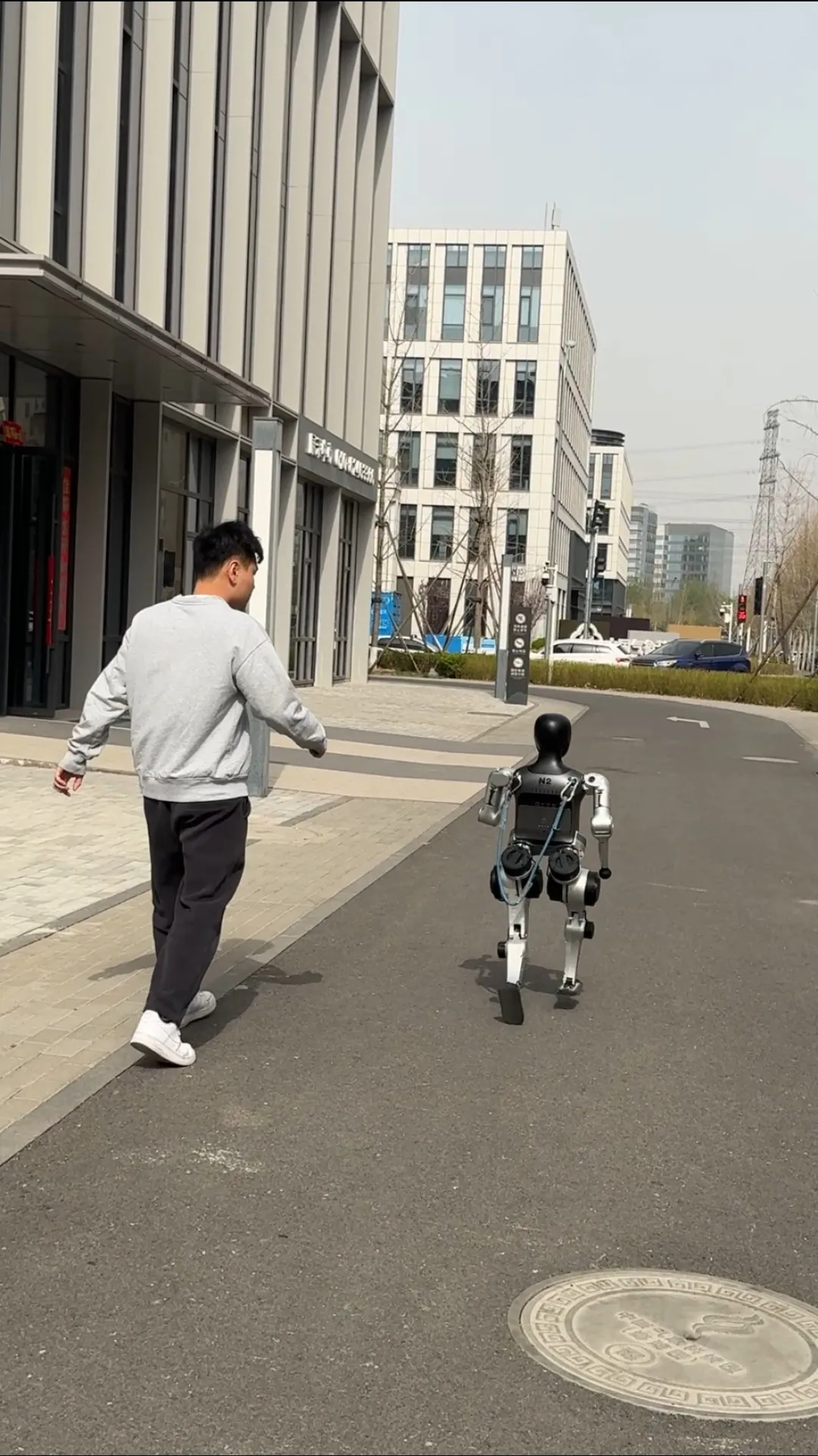
Training in front of the company, Songyan Power’s N2
Sometimes, Jiang Zheyuan drives the engineers, following the robot like a wedding car, saying, “It’s too tiring to run behind, we can’t keep up; it becomes a test for the humans, not the robots.” Sometimes the engineers take turns to share the burden.
Imagine a 1.8-meter engineer running alongside a 1.1-meter child-sized N2; it looks somewhat comical. This also attracts spectators during each training session. On the day “Houlang Research Institute” visited Songyan Power, many passersby were seen filming N2 and even waving to it to “come over!” However, the security at the park entrance has long since gotten used to it.
In addition, the marathon poses a significant test for the robots’ endurance capabilities.
The official rules state that robots can change batteries and can run the entire distance in a relay format with “teammates”, but changing a robot incurs a penalty time of 10 minutes. Each company is calculating their own “little calculations” regarding this.
Songyan Power is quietly developing a “range extension technology” that allows robots to charge while running, aiming to reduce the time spent changing batteries—although changing a battery only takes 2-3 minutes, the restarted robot still needs to be debugged.
For these robot companies, this is not only the first public appearance of their “children” in front of a national audience but also the first time they are competing directly with “other people’s children”.
Even the organizers, like a primary school teacher assigning a class leader to each child, set up special awards for completion, endurance, popularity, gait, and creative form, in addition to the top three winners.
Thus, each robot company is putting in their utmost effort to ensure their “children” perform well on the track.
For example, Songyan Power prepared to send two competitors to the field—one that runs fast and one that runs “like a human”. The fast one is responsible for the results, while the one that runs “like a human” is responsible for showcasing skills. “At this stage, showcasing is very important,” Jiang Zheyuan said. To this end, the team formed two groups, each with one main robot and two backups.
However, achieving a spectacular debut is not easy.
At the end of March, the participating robot companies and teams arrived in Beijing for on-site rehearsals.
Robot marathons test not only the machines but also the people controlling them. “If a machine breaks down, we can just replace it, but for humans, there are still many uncontrollable accidents,” Chen Chunyu said. Therefore, Magic Atom decided to prioritize Xiaomai’s safety over speed, “because on that day, with all the machines and humans, it is possible to slow down Xiaomai’s speed; humans can flexibly handle various strategies.”
However, if Xiaomai falls or does not perform well, Chen Chunyu believes it is acceptable, “It won’t have a significant impact on our consumers, and we are showing the final sales version of the machine, indicating that we are willing to take on challenges on such a stage.” As the first national competition for humanoid robots, Chen Chunyu believes that the audience will be relatively forgiving towards the robots.
After all, the “crash scene” of a steel body making close contact with concrete is also a form of performance art that is hard to come by.

A large-scale “performance” by robots
Unexpectedly, this kind of performance art began at the starting line.
The Yushu robot fell at the starting line but then performed a backflip and, after getting up, waved its hand and continued running. However, the robot “Huanhuan”, the only one with a bionic human head, was not so lucky; less than 3 minutes into the race, its leg broke, and it had to withdraw.
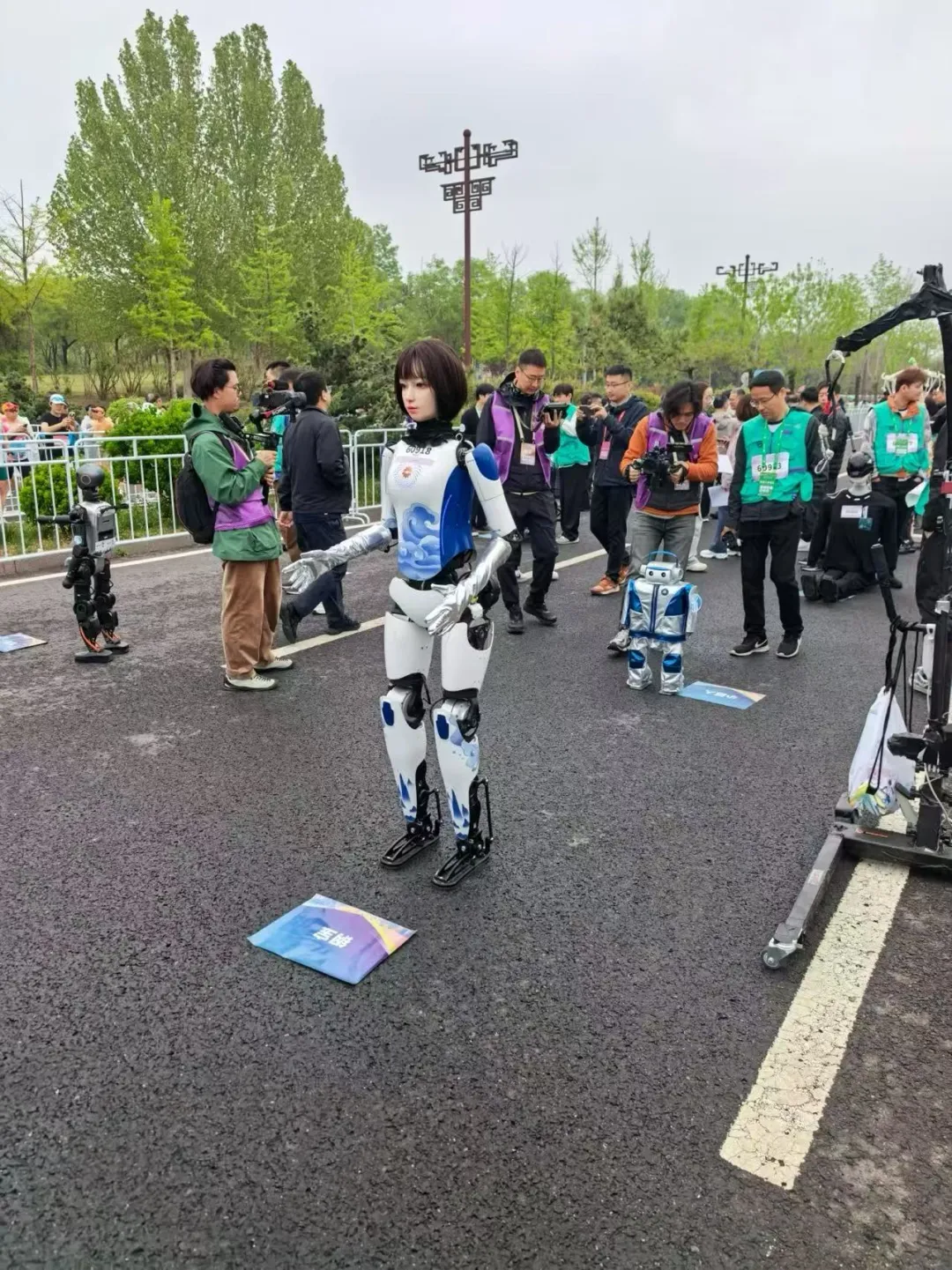
Huanhuan robot
Also regrettably, Magic Atom, which had been preparing for some time, was unable to participate due to scheduling issues.
Aside from the leading Tiangong Ultra and Songyan Power’s “Little Rascal” and “Whirlwind Kid”, most of the other robot competitors did not seem to pursue speed too much, some even relaxed as if strolling. The “Youma Dangsian” team’s BoosterTI stopped to dance when passing a spot with many spectators. Well, if you can’t run fast, just perform; this is what the audience wants. The smallest “Little Giant” waved its short arms as it passed by.
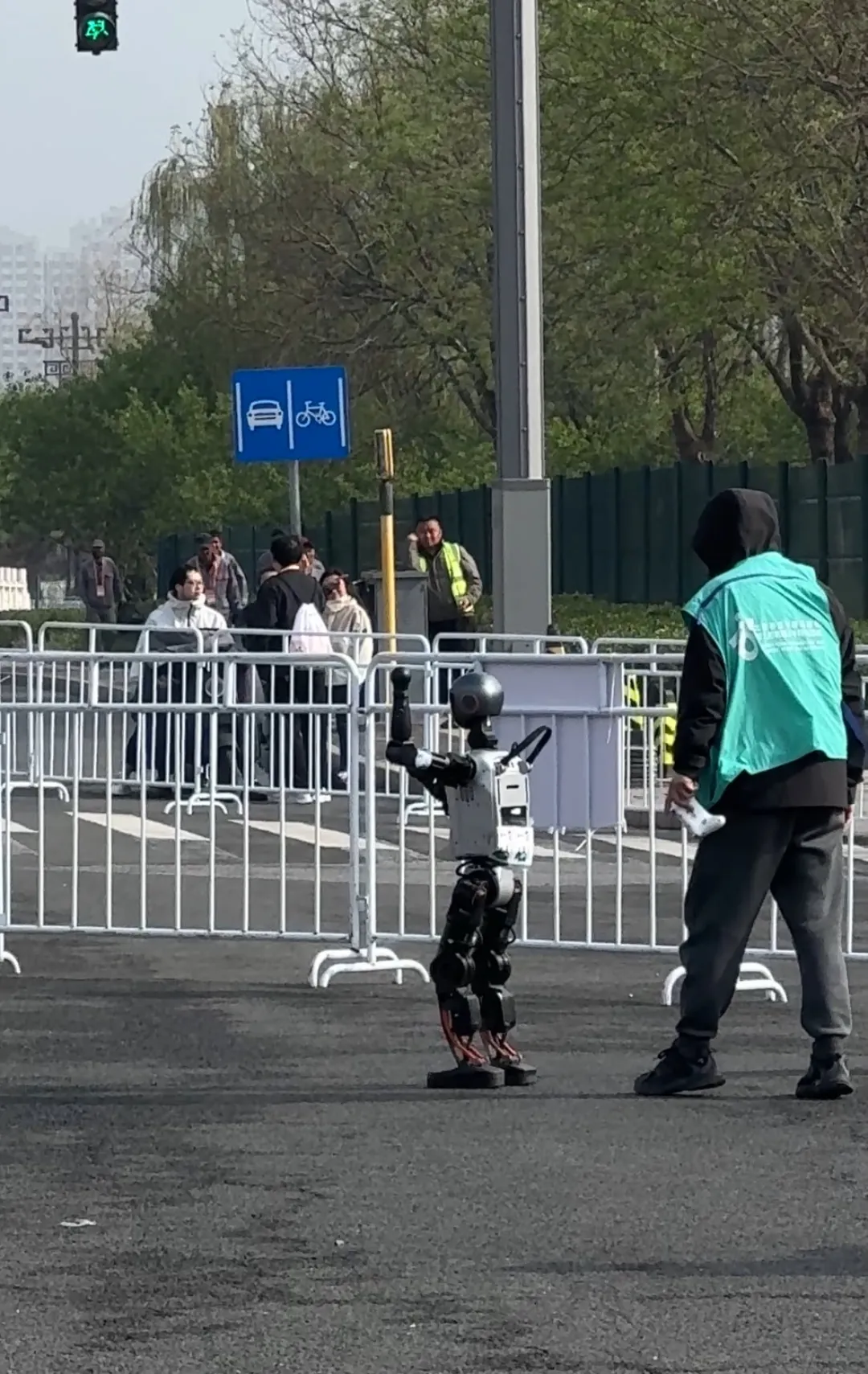
BoosterTI
By the time the 10th robot passed a junction 3 kilometers from the starting line, the champion of the human marathon had already been determined.
As Jiang Zheyuan said, this is a test for the robots, and also a large-scale showcase. To prepare for this showcase, each robot team has made ample preparations.
Songyan Power ultimately did not attach insoles to the competitors but instead put on size 29 running shoes and added three positioning pins to alleviate structural damage caused by excessive impact. Meanwhile, the Tsinghua Tongban team equipped the Kuafu robot with knee and elbow pads; to cool the robot’s joints, accompanying runners had to check the robot’s joint temperature regularly and spray cooling liquid and mist; when the robot’s battery was low, they had to change it promptly.
In contrast, the “Little Rascal” was the only competitor that did not require much effort from its accompanying runners; while other runners had to hold the tether to protect the robot, the “Little Rascal”‘s accompanying runners mostly sat in the referee car at the back.
However, it is clear that Songyan Power is still eager for results, at least its founder Jiang Zheyuan is.
As a large crowd gathered at the finish line to welcome the champion of the robot marathon, Jiang Zheyuan stood on something higher than others, wearing a “Victory” headband, gazing at the finish line.
At 10:10 AM, the first competitor, Tiangong Ultra, crossed the finish line amidst the cheers of the audience, completing the race in 2 hours and 40 minutes, reportedly only changing batteries once.

Tiangong Ultra sprinting to the finish line
One hour later, Songyan Power’s “Little Rascal” successfully crossed the finish line, securing second place. At 11:18 AM, the “Whirlwind Kid”, whose head was taped back on after falling off, also crossed the finish line third (thankfully, in the robot marathon, the head’s role is not significant). Jiang Zheyuan shouted, “Songyan Power!” as the two robots’ accompanying runners and algorithm engineers followed suit, shouting “Awesome!”

Songyan Power robots converging at the finish line
Afterwards, the two competitors at the finish line put on a talent show for the media and the audience—running side by side and stepping in sync.
Jiang Zheyuan could not contain his excitement, expressing to the media, “I am thrilled to have secured two of the top three finishers!” while introducing himself, “From Tsinghua, born in October 1998.” When asked by the media to share the reasons for their successful run, he simply replied with four words: “Effort and struggle.”
(According to official news, the third place was awarded to the “Walker II Team”; the originally third-place “Whirlwind Kid Team” was penalized for changing robots midway and ultimately finished fourth.)